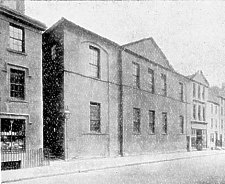
Athol St 'National 'School built 1813, (later St Georges) (c.1896)

Athol St 'National 'School built 1813, (later St
Georges) (c.1896)
Two early pioneers in the field of mass education for the poor were Andrew Bell and Joseph Lancaster. The basis of both of their schemes was the monitorial system whereby a single master educated the older boys who in turn passed on their knowledge to the younger boys. As could be expected this led to merely rote learning with little real education. However imparting real education was not the intention as 'there was a risque of elevating by an indescriminate education the minds of those doomed to the drudgery of daily labour'.
Followers of Lancaster formed a committee to encourage the foundation of such schools in 1809, which in 1814 became the British and Foreign School Society. Such schools, founded by local efforts, would offer undenominational religious teaching. Such a transfer of power out of the hands of the Established Church was not acceptable to this powerful lobby and thus a rival National Society for Promoting the Education of the Poor in the Principles of the Established Church was founded to encourage similar schools but based on Andrew Bell's principles and under which the local clergy would retain control.
Founded as a boys school in April 1810 by subscribers and initially established in Mucklesgate, it moved to rented premises (the New Room) in the newly built Athol Street (not yet the home of the Manx Legal Profession) in January 1811 allowing a girls' school to be established at Mucklesgate. Described as a school agreeable to Mr Lancaster's plan it was, as Hinton Bird comments, very much a creature of the Established Church, being partially supported by annual sermons, thus in 1813 the title was quietly changed to 'Day and Sunday School' when a purpose built building, also accomodating girls, designed by John Taggart, opened on 10 Feb 1813, also in Athol Street. This building had cost £1,118 8s 8d. It offerred free education to the poor of Douglas - in 1814 it was made compulsory for those on poor relief (there was no Manx equivalent of the English poor law) to send their children there - in an 1821 description it was stated that of the 119 boys at the school, 72 were destitute of shoes and stockings. Apart from the annual sermon, and some early bequests much of the funding was by subscribers who for their annual £1 1s were allowed to nominate two scholars.
It was noticed by Hannah Bullock in 1816 with the words:
The Lancastrian school has also been an essenntial public benefit, and a very visible improvement has taken place in the children of the poor since its institution. Establishments of the same kind, but on a smaller scale, have been set on foot in Ramsay and Castletown, from whence it may be hoped, that the blessings of education which not many years since were unattainable even by the higher ranks in the island, will now be extended to the lowest.
though she had commented that, like the House for the Reception of the Poor, most of the subscriptions came from the non-Manx 'strangers'.
Lord Teignmouth, writing of 1829, notes it as following:
The free-school at Douglas consists of 110 boys, and the same number of girls : many of the latter were clad in a neat uniform at the expense of their parents. The children contribute one penny per week each to the cost of their education ; and yet, notwithstanding the excellence of the instruction afforded, they attend with reluctance, showing a preference to other schools, at which they pay the usual fees, because exempt from that regular attendance which is exacted at the free-school.
A short early history was given in IoM Charities of 1831 (though the attendance figures date from c.1827).
The first master was John Radcliffe who retired in 1819, to be followed by William Cain - the salary was advertised at between 40 to 50 pounds [per year]. According to Hinton Bird, Cain died, aged only 29, in 1826 to be followed by James Cretney (described by Manx Advertiser as a Printer by trade) though the 1823 directoiry already lists him as Master. The 1820's however saw a fall off in subscriptions and numbers declined from the high of 160 boys/150 girls in 1827 to 120/120 in 1831/3. Finances improved in the 1830's and numbers again rose to around 300; an assistant master J Fell joining in the late 1830's.
In 1837 Pigot's directory reported 'NATIONALSchool,Athol st-James Cretney, master; Jane Kneale, mistress' and described it as capable of accomodating 1000 pupils. In 1848 Quiggin's directory reported 'National school, Atholl st—-J Cretney, master; Jessie McCulloch, mistress'. By 1851 'National School, Atholl street, T Whiter, master; K H Winter, mistress'. By 1863 it was known as St George's to distinguish from St Barnabas' which was also ran on National School lines: 'St. George's, Atholl street: William Battersby, h. 4 Dalton terrace, master; and Margaret Lewin, h. Douglas Bridge, mistress' (William Battersby was aged 28 in 1861 census, married to an English wife, Jane Harriet, with a 1 year old boy born in Douglas).
In 1895 became part of the Board Schools - closed 1907 when Demesne road Boy's school opened allowing Tynwald Street school to become the Girls' School.
G. Sutherland Elementary Education in the Nineteenth Century (Booklet G76) London: Historical Association 1971
Hinton Bird The Island that led - The History of Manx Education vol 1 pp222/5
|
School's Index |
||
|
|
||
|
Any comments, errors or omissions
gratefully received The
Editor |
||